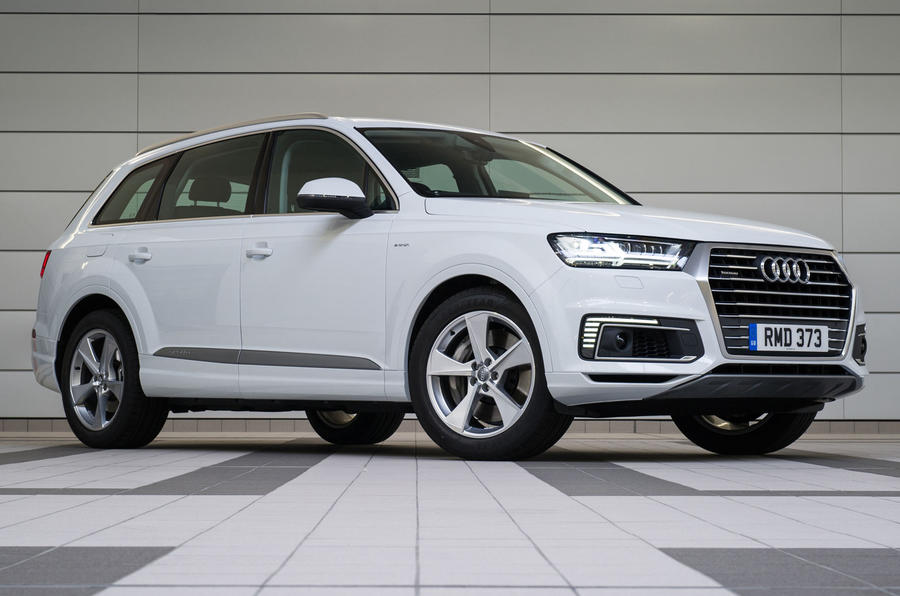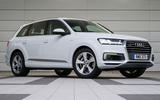What is it?
This is the latest addition to Audi’s e-tron range: a plug-in hybrid version of the big Audi Q7 SUV. Like the significantly smaller Audi A3 e-tron, there’s an internal combustion engine under the bonnet that’s coupled to an electric motor and battery pack.
Unlike the BMW X5 xDrive40e and Volvo XC90 T8, you won’t find a petrol-fired four-cylinder turbo engine under the bonnet of the Q7 e-tron, driven for the first time on UK roads. Instead, there’s an optimised version of the 3.0 TDI V6 that can be found in the regular Q7. In this application, it produces 254bhp.
Under the boot floor lives 202kg of battery pack and assorted electrical hardware, robbing the Q7 of its ability to seat seven. Load capacity is reduced by a sizeable 120 litres, but the 650 litres that are left should still be enough for the vast majority of families.
That battery may seem like a hefty thing, but it’s still only enough to provide a maximum electric range of 34 miles.
What's it like?
With all this talk of economy, emissions and the small matter of a 2.5-tonne-plus kerb weight, you might expect the Q7 to feel sluggish compared with the regular 268bhp model. That is most definitely not the case.
With the diesel and electric motors combined, total system output is 369bhp and 516Ib ft of torque. That’s good enough for performance that would make many a hot hatch blush. Not only does it look quick on paper, but the instantaneous torque of the electric motor also means it feels effortless in the way it piles on speed.
The hybrid system doesn’t just make for plenty of punch; it’s smooth, too. As long as there’s some charge, the e-tron will pull away on electricity alone. As speed increases, there’s barely a murmur from beneath the bonnet when the V6 fires up, and the diesel power is introduced in a refined manner.
To help you to get the best out of the e-tron, the accelerator pedal is capable of delivering feedback. You have to physically push past a certain point to get the diesel motor to fire and the pedal can push back slightly to promote coasting. As there is no set point for this feedback to occur, it can feel slightly odd at times. You do get used to it, though.
Of course, like all plug-in hybrids, they only make sense if you have somewhere to charge them. After you’ve used up your battery, in effect you have a hybrid car with a lot more weight to lug about. We quickly saw economy drop from an indicated 70-80mpg down to less than 40mpg – about what you’d get from the standard Q7.
One area that does feel quite different is the handling. Despite our test car having the optional and very worthwhile adaptive air suspension, it couldn’t quite mask the additional mass the e-tron carries over the regular Q7. To be fair to it, there’s very little difference under normal driving conditions; you have to lean on it before the differences become apparent.
When slowing from speed, the e-tron feels like it’s that bit heavier than the standard car (because it is), and it can’t corner as well. Sure, the Q7 isn’t the sharpest-handling SUV out there, but the e-tron has that little bit more body roll and feels more ponderous when changing direction.
As for the interior, it’s not that dissimilar to a conventionally powered Q7. The dash is still a wonderful piece of minimalist design, the seats are comfortable and there’s plenty of space for rear seat passengers. Only some subtle badging and the addition of a battery level indicator really set it apart. You also get Audi’s Virtual Cockpit and an electric tailgate as standard.



























Join the debate
Add your comment
This is another ridiculous product from Audi
This is why this car will be no match for the Volvo T8 Hybrid that uses a petrol smaller supercharged and turbo charged engine, and you get to keep your 7 seats, and seriously more refined inside. Definitely a winner
Even if you do fit this very
Price